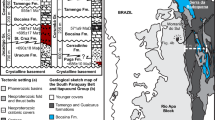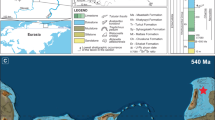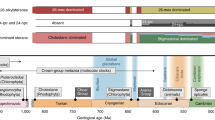Abstract
THE fossil record sheds little light on the problem of metazoan origins. Most of the major metazoan phyla appear in the fossil record in the Cambrian but no ancestral organisms have been found in the Precambrian, although suitable non-metamorphosed Precambrian rocks exist1. The oldest known metazoan fossils (latest Precambrian) are those from the Ediacara formation, Australia2. These fossils represent soft-bodied metazoans, some of which have been assigned to the coelenterates, some to the annelids, while others are of uncertain phyla3. Glaessner suggests2 that the Ediacara animals may be significant as a stage in the evolution of small, soft-bodied animals to larger forms with the gradual acquisition of fossilizable exo-skeletons or shells.
This is a preview of subscription content, access via your institution
Access options
Subscribe to this journal
Receive 51 print issues and online access
$199.00 per year
only $3.90 per issue
Buy this article
- Purchase on SpringerLink
- Instant access to full article PDF
Prices may be subject to local taxes which are calculated during checkout
Similar content being viewed by others
References
Cloud, jun., P. E., in Evolution and Environment (edit. by Drake, E. T.), 1 (Yale Univ. Press, New Haven, 1968).
Glaessner, M. F., Biol. Rev., 37, 467 (1962).
Glaessner, M. F., and Wade, M., Paleontology, 9, 599 (1966).
Berkner, L. V., and Marshall, L. C., Proc. US Nat. Acad. Sci., 53, 1215 (1965).
Cloud, jun., P. E., Science, 148, 27 (1965).
Towe, K. M., Proc. US Nat. Acad. Sci., 65, 781 (1970).
Prosser, C. L., and Brown, jun., F. A., Comparative Animal Physiology, second ed. (Saunders, Philadelphia and London, 1961).
Josse, J., and Harrington, W. F., J. Mol. Biol., 9, 269 (1964).
Krogh, A., The Comparative Physiology of Respiratory Mechanisms (Univ. of Pennsylvania Press, Philadelphia, 1959).
Blum, J. J., and Jenden, D. J., Arch. Biochem. Biophys., 66, 316 (1957).
Raff, E. C., and Blum, J. J., J. Theoret. Biol., 18, 53 (1968).
Chance, B., Fed. Proc., 16, 671 (1957).
MacGintie, C. E., and MacGintie, N., Natural History of Marine Animals (McGraw-Hill, New York, 1949).
Bouillon, J., in Chemical Zoology (edit. by Florkin, M., and Scheer, B. T.), 2, 81 (Academic Press, New York and London, 1968).
Hyman, L. H., The Invertebrates, 1 (McGrawHill, New York, 1940).
Simpson, G. G., in Evolution after Darwin, the Evolution of Life (edit. by Tax, S.), 1, 117 (University of Chicago Press, Chicago, 1969).
Manwell, C., Ann. Rev. Physiol., 22, 191 (1960).
Jones, J. D., J. Exp. Biol., 32, 110 (1955).
Wolvekamp, H. P., and Vreede, M. C., Arch. Néerl. Physiol., 25, 265 (1941).
Winzler, R. J., J. Cell Comp. Physiol., 17, 263 (1941).
Hadzi, J., Syst. Zool., 2, 145 (1953).
Schopf, J. W., and Barghoorn, E. S., J. Paleontology, 43, 111 (1969).
Beauchamp, P. de, in Traité, de Zoologie (edit. by Grassé, P. P.), 4, 35 (Masson, Paris, 1961).
Vernberg, W. B., in Chemical Zoology (edit. by Florkin, M., and Scheer, B. T.), 2, 359 (Academic Press, New York and London, 1968).
National Academy of Sciences, Handbook of Respiration (Saunders, Philadelphia, 1958).
Manwell, C., Comp. Biochem. Physiol., 1, 277 (1960).
Author information
Authors and Affiliations
Rights and permissions
About this article
Cite this article
RAFF, R., RAFF, E. Respiratory Mechanisms and the Metazoan Fossil Record. Nature 228, 1003–1005 (1970). https://doi.org/10.1038/2281003a0
Received:
Issue date:
DOI: https://doi.org/10.1038/2281003a0
This article is cited by
-
Co-evolution of eukaryotes and ocean oxygenation in the Neoproterozoic era
Nature Geoscience (2014)
-
Redox condition during Ediacaran–Cambrian transition in the Lower Yangtze deep water basin, South China: constraints from iron speciation and δ 13Corg in the Diben section, Zhejiang
Chinese Science Bulletin (2014)
-
The evolutionary consequences of oxygenic photosynthesis: a body size perspective
Photosynthesis Research (2011)
-
Terminal Proterozoic reorganization of biogeochemical cycles
Nature (1995)



